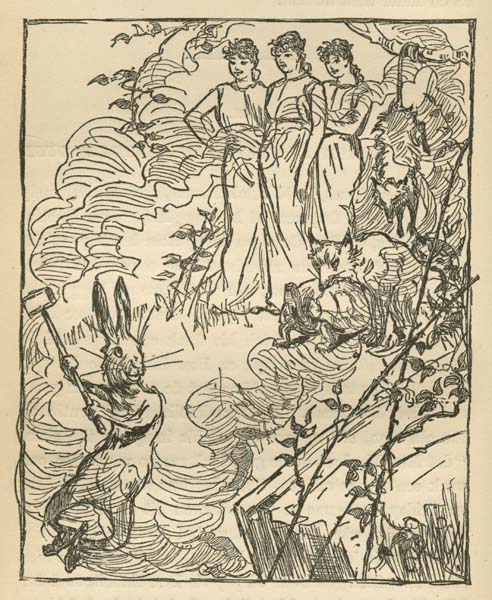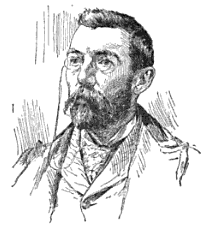|
J. M. Condé
J. M. Condé was an early 20th century "golden age" book illustrator and comic strip artist best known for his ink and watercolor illustrations for books by Joel Chandler Harris and Albert Bigelow Paine. He also worked on at least two comic strips, one of which was derived from Harris's " Br'er Rabbit" stories. Career Condé worked in what is known as the golden age of American illustration in the early 20th century. His energetic line work calls to mind the work of his contemporary A. B. Frost, while his use of vivid color evokes Winsor McKay. He specialized in illustrations of animals in books for children. Condé illustrated the "Hollow Tree" books of Albert Bigelow Paine and some of Joel Chandler Harris's "Uncle Remus" stories, as well as books by Martha Strudwick Young and '' Aesop's Fables''. Like some other illustrators of the day, Condé attempted to show animals as if drawn from life, though he also followed the 'humanizing' line of traditional animal fables and us ... [...More Info...] [...Related Items...] OR: [Wikipedia] [Google] [Baidu] |
Joel Chandler Harris
Joel Chandler Harris (December 9, 1848 – July 3, 1908) was an American journalist, fiction writer, and folklorist best known for his collection of Uncle Remus stories. Born in Eatonton, Georgia, where he served as an apprentice on a plantation during his teenage years, Harris spent most of his adult life in Atlanta working as an associate editor at ''The Atlanta Constitution''. Harris led two professional lives: as the editor and journalist known as Joe Harris, he supported a vision of the New South with the editor Henry W. Grady (1880–1889), which stressed regional and racial reconciliation after the Reconstruction era. As Joel Chandler Harris, fiction writer and folklorist, he wrote many 'Brer Rabbit' stories from the African-American oral tradition. Life Education: 1848–1862 Joel Chandler Harris was born in Eatonton, Georgia, in 1848 to Mary Ann Harris, an Irish immigrant. His father, whose identity remains unknown, abandoned Mary Ann and the infant shortly afte ... [...More Info...] [...Related Items...] OR: [Wikipedia] [Google] [Baidu] |
Albert Bigelow Paine
Albert Bigelow Paine (July 10, 1861 – April 9, 1937) was an American author and biographer best known for his work with Mark Twain. Paine was a member of the Pulitzer Prize Committee and wrote in several genres, including fiction, humor, and verse."Albert B. Paine, 76, Biographer, Dead." ''The New York Times'' April 10, 1937: 19. Biography Paine was born in New Bedford, Massachusetts, the son of Vermont farmer Samuel Estabrook Paine and Massachusetts shopkeeper Mercy Coval Kirby Paine, and was moved to Bentonsport, Iowa when he was one year old. From early childhood until early adulthood, Paine lived in the village of Xenia in southern Illinois; here he received his schooling. His home in Xenia is still standing. At the age of twenty, he moved to St. Louis, where he trained as a photographer, and became a dealer in photographic supplies in Fort Scott, Kansas. Paine sold out in 1895 to become a full-time writer, moving to New York. He spent most of his life in Europe, in ... [...More Info...] [...Related Items...] OR: [Wikipedia] [Google] [Baidu] |
Br'er Rabbit
Br'er Rabbit (an abbreviation of ''Brother Rabbit'', also spelled Brer Rabbit) is a central figure in an oral tradition passed down by African-Americans of the Southern United States and African descendants in the Caribbean, notably Afro-Bahamians and Turks and Caicos Islanders. He is a trickster who succeeds by his wits rather than by brawn, provoking authority figures and bending social mores as he sees fit. Popularly known adaptations of the character was originally written by Joel Chandler Harris in the 19th century, and later by Walt Disney Productions adapted it for the film '' Song of the South'' in 1946. __TOC__ African origins The Br'er Rabbit stories can be traced back to trickster figures in Africa, particularly the hare that figures prominently in the storytelling traditions in West, Central, and Southern Africa. Among the Temne people in Sierra Leone, they tell children stories of a talking rabbit. Other regions of Africa also tell children stories o ... [...More Info...] [...Related Items...] OR: [Wikipedia] [Google] [Baidu] |
Condé LaF
Condé is a French place name and personal name. It is ultimately derived from a Celtic word, "Condate", meaning "confluence" (of two rivers) - from which was derived the Romanised form "Condatum", in use during the Roman period, and thence to the French "Condé" found at various locations. It may refer to: People with this surname *Alpha Condé (born 1938), Guinean politician *J. M. Condé, early 20th century illustrator *Maryse Condé (born 1937), Guadeloupean author *Miguel Condé (born 1939), Mexican painter *Sékou Condé (born 1993), Guinean footballer People with this first name * Condé Montrose Nast, American publisher Places *Château de Condé, a private estate in Condé-en-Brie, Aisne, France Places in France that contain the element ''Condé'' *Condé, Indre, in the Indre ''département'' *Condé-en-Brie, in the Aisne ''département'' *Condé-Folie, in the Somme ''département'' *Condé-lès-Autry, in the Ardennes ''département'' *Condé-lès-Herpy, in the Ard ... [...More Info...] [...Related Items...] OR: [Wikipedia] [Google] [Baidu] |
Winsor McKay
Zenas Winsor McCay ( – July 26, 1934) was an American cartoonist and animator. He is best known for the comic strip ''Little Nemo'' (1905–14; 1924–26) and the animated film '' Gertie the Dinosaur'' (1914). For contractual reasons, he worked under the pen name Silas on the comic strip ''Dream of the Rarebit Fiend''. From a young age, McCay was a quick, prolific, and technically dextrous artist. He started his professional career making posters and performing for dime museums, and in 1898 began illustrating newspapers and magazines. In 1903 he joined the ''New York Herald'', where he created popular comic strips such as ''Little Sammy Sneeze'' and ''Dream of the Rarebit Fiend''. In 1905 his signature strip ''Little Nemo in Slumberland'' debuted—a fantasy strip in an Art Nouveau style about a young boy and his adventurous dreams. The strip demonstrated McCay's strong graphic sense and mastery of color and linear perspective. McCay experimented with the formal elements of t ... [...More Info...] [...Related Items...] OR: [Wikipedia] [Google] [Baidu] |
Martha Strudwick Young
Martha Strudwick Young (Jan. 11, 1862–May 9, 1941) was an American regionalist writer known for her recounting of Southern folk tales, fables, and songs of black life in the plantation era. She was admired by other writers for her skill with dialect. Young was inducted into the Alabama Women's Hall of Fame in 1986. Early life and education Martha Strudwick Young was the daughter of Confederate physician and surgeon Elisha Young and Anne Eliza Ashe (Tutwiler) Young. The women's education and prison reform advocate Julia Strudwick Tutwiler was her aunt. Her family moved to nearby Greensboro after the Civil War, and it was there that she learned the Southern folk tales and stories of African-American culture that would form the basis of her later writings. Young was educated at the Green Springs School (which had been founded by her grandfather Henry Tutwiler as a school for boys), the Greensboro Female Academy, and the Tuscaloosa Female Academy before graduating from the Livings ... [...More Info...] [...Related Items...] OR: [Wikipedia] [Google] [Baidu] |
Aesop's Fables
Aesop's Fables, or the Aesopica, is a collection of fables credited to Aesop, a slave and storyteller believed to have lived in ancient Greece between 620 and 564 BCE. Of diverse origins, the stories associated with his name have descended to modern times through a number of sources and continue to be reinterpreted in different verbal registers and in popular as well as artistic media. The fables originally belonged to oral tradition and were not collected for some three centuries after Aesop's death. By that time, a variety of other stories, jokes and proverbs were being ascribed to him, although some of that material was from sources earlier than him or came from beyond the Greek cultural sphere. The process of inclusion has continued until the present, with some of the fables unrecorded before the Late Middle Ages and others arriving from outside Europe. The process is continuous and new stories are still being added to the Aesop corpus, even when they are demonstrably ... [...More Info...] [...Related Items...] OR: [Wikipedia] [Google] [Baidu] |
Frank Ver Beck
William Francis "Frank" Ver Beck (June 1, 1858 – July 13, 1933) was an American illustrator known for his comedic drawings of animals. Biography Ver Beck was born in Richland Township, Belmont County, Ohio as the son of a shoemaker. He studied art and woodcarving under Mansfield, Ohio artist Robert R. "Railroad" Smith and worked as a wood engraver. In 1881 or 1882, Ver Beck moved to New York City. There he studied art and became a freelance illustrator for magazines including ''Scribner's'', '' The Ladies Home Journal'', and ''Collier's''. In 1894 in ''Munsey's Magazine'', Harold Payne wrote:For quaintness of conceit and weirdness of treatment William Francis Ver Beck has no parallel. His specialty is in making animals, and particularly reptiles, to represent human beings in comical situations. He invests crocodiles, turtles, lizards, frogs, and other amphibiae with human attributes, places them in all sorts of ludicrous positions, and carries them through endless laughab ... [...More Info...] [...Related Items...] OR: [Wikipedia] [Google] [Baidu] |
The Hollow Tree And Deep Woods Book
''The Hollow Tree and Deep Woods Book'' is a children's book of short stories by Albert Bigelow Paine. It was published first in 1898 as an edition in one volume of ''The Hollow Tree'' and ''In the Deep Woods'' with several new stories and pictures added. The book has 28 animal stories, notably tales of the 'Coon, the 'Possum, and the Old Black Crow, which live in the Hollow Tree in the Deep Woods. These books contain pen-and-ink illustrations by J. M. Condé. The Hollow Tree Series *''The Hollow Tree and Deep Woods Book'' (1898) *''The Hollow Tree Snowed-In Book'' (1910) *''Hollow Tree Nights and Days ''Hollow Tree Nights and Days'' is a children's book written by Albert Bigelow Paine and illustrated by J. M. Condé. It was published by Harper & Brothers Harper is an American publishing house, the flagship imprint of global publisher Harp ...'' (1915) External links * 1898 short story collections Children's short story collections American short story collectio ... [...More Info...] [...Related Items...] OR: [Wikipedia] [Google] [Baidu] |
The Hollow Tree Snowed-In Book
''The Hollow Tree Snowed-In Book'' is a children's book of short stories written by Albert Bigelow Paine and illustrated by J. M. Condé. It was published by Harper & Brothers in 1910. The book contains the continued tales of the 'Coon, the 'Possum, and the Old Black Crow, who live in the Hollow Tree in the Deep Woods. These books contain pen-and-ink illustrations of the stories. The general setting of this book is 'the story teller' who sits in a rocking chair in front of the old fireplace, with the 'Little Lady' sitting on his lap as he smokes a pipe and tells the old stories of the Hollow Tree Folk. All the stories in this book are stories told by the various characters when there is a big snow storm and they get snowed in. To pass the time they tell stories. Editions There are two editions of this book. Both have an embossed picture on the front of Mr. Rabbit and Mr. Turtle at the door to the hollow tree being greeted by Mr. Crow. Both editions have a dark green backgrou ... [...More Info...] [...Related Items...] OR: [Wikipedia] [Google] [Baidu] |



_-_Foto_G._Dall'Orto_5_ago_2006.jpg)
